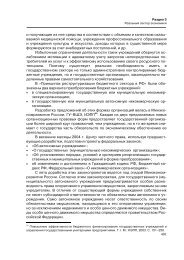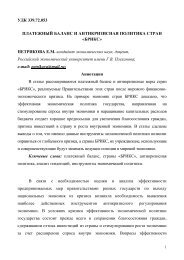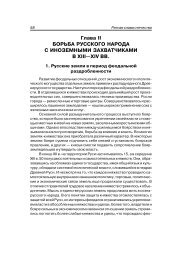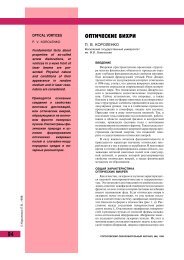Chapter 1: On <strong>the</strong> Path toward Def<strong>in</strong><strong>in</strong>g <strong>Strategic</strong> <strong>Stability</strong>The USSR <strong>and</strong> United States de facto crafted <strong>the</strong> ma<strong>in</strong> elements of <strong>the</strong> approach toward strategicstability <strong>in</strong> <strong>the</strong> sphere of nuclear weapons <strong>in</strong> <strong>the</strong> period that began <strong>in</strong> <strong>the</strong> late 1960s, when <strong>the</strong>ylaunched a serious discussion on problems of reduc<strong>in</strong>g <strong>and</strong> limit<strong>in</strong>g strategic weapons, <strong>in</strong>clud<strong>in</strong>gboth offensive <strong>and</strong> defensive weapons (although different term<strong>in</strong>ology was used <strong>in</strong> <strong>the</strong> discussionsthat took place <strong>in</strong> <strong>the</strong> 1960s <strong>and</strong> 1970s).Those discussions took place at a time when <strong>the</strong>re were formidable differences <strong>in</strong> <strong>the</strong> structure ofSoviet <strong>and</strong> U.S. strategic nuclear forces, as well as <strong>in</strong> <strong>the</strong> two sides’ political <strong>and</strong> strategic cultures.But <strong>the</strong>se differences were neutralized by <strong>the</strong> fact that <strong>the</strong> elites on both sides (which <strong>in</strong>cluded<strong>in</strong>creas<strong>in</strong>g numbers of technocrats <strong>and</strong> neo-technocrats) recognized <strong>the</strong> reality of technologicalevolution <strong>in</strong> <strong>the</strong> doma<strong>in</strong> of nuclear missiles—an evolution whose logic was identical to <strong>the</strong> logicof scientific <strong>and</strong> technical development. By that time, both sides had also developed <strong>and</strong> accumulatedassessments of <strong>the</strong> <strong>in</strong>credibly devastat<strong>in</strong>g consequences that a war with use of nuclearweapons would entail. These assessments, which political leaders on both sides were able to comprehend,played an important role <strong>in</strong> <strong>the</strong> aforementioned discussions.The majority of <strong>the</strong> political elites <strong>and</strong> military-<strong>in</strong>dustrial complex leaders began to view nuclearwar (to be more precise, a war with massive use of nuclear weapons) as suicidal, even as bothsides cont<strong>in</strong>ued to work at an <strong>in</strong>creas<strong>in</strong>gly fast pace on <strong>the</strong> development of advanced means ofwag<strong>in</strong>g nuclear war. These leaders’ perceptions were <strong>in</strong> part shaped by <strong>the</strong>ir memories of <strong>the</strong> horrorsof World War II; <strong>the</strong>y remembered that <strong>the</strong> Soviet Union <strong>and</strong> <strong>the</strong> United States were allied<strong>in</strong> <strong>the</strong> fight aga<strong>in</strong>st <strong>the</strong> Nazis. Their memories of <strong>the</strong> October 1962 Cuban Missile Crisis werealso fresh. Back <strong>the</strong>n, <strong>the</strong> Soviet Union <strong>and</strong> <strong>the</strong> United States found <strong>the</strong>mselves on <strong>the</strong> br<strong>in</strong>k of anuclear war with each o<strong>the</strong>r. 5 (Some estimated that a nuclear war between <strong>the</strong> Soviet Union <strong>and</strong><strong>the</strong> U.S. would have killed 100 million American <strong>and</strong> Soviet citizens while caus<strong>in</strong>g many millionsof casualties <strong>in</strong> Western <strong>and</strong> Eastern Europe.) 6 In <strong>the</strong> aftermath of that crisis, a hotl<strong>in</strong>e was establishedbetween Moscow <strong>and</strong> Wash<strong>in</strong>gton <strong>in</strong> June 1963, <strong>and</strong> this hotl<strong>in</strong>e is operational to date.Also, <strong>in</strong> August 1963, <strong>the</strong> Treaty bann<strong>in</strong>g Nuclear Weapon Tests <strong>in</strong> <strong>the</strong> Atmosphere, <strong>in</strong> OuterSpace <strong>and</strong> Under Water was signed <strong>in</strong> Moscow <strong>in</strong> what became an important contribution to <strong>the</strong>cause of streng<strong>the</strong>n<strong>in</strong>g strategic stability. And <strong>in</strong> 1968, <strong>the</strong> Treaty on <strong>the</strong> Non-Proliferation ofNuclear Weapons (NPT) was concluded. Article VI of that treaty committed <strong>the</strong> nuclear powers“to pursue negotiations <strong>in</strong> good faith on effective measures relat<strong>in</strong>g to cessation of <strong>the</strong> nucleararms race at an early date <strong>and</strong> to nuclear disarmament, <strong>and</strong> on a Treaty on general <strong>and</strong> completedisarmament under strict <strong>and</strong> effective <strong>in</strong>ternational control.” (For <strong>in</strong>stance, while develop<strong>in</strong>g itsnuclear weapons, India was cont<strong>in</strong>uously criticiz<strong>in</strong>g <strong>the</strong> USSR <strong>and</strong> <strong>the</strong> U.S. for not properly fulfill<strong>in</strong>g<strong>the</strong>ir Article VI commitments.) As for countries that had no nuclear weapons as of 1967, <strong>the</strong>ycommitted to not seek<strong>in</strong>g such weapons by sign<strong>in</strong>g <strong>the</strong> treaty. Four American th<strong>in</strong>kers (GeorgeShultz, 7 William Perry, 8 Henry Kiss<strong>in</strong>ger, 9 <strong>and</strong> Sam Nunn 10 ) wrote a widely acclaimed article titled“A World Free of Nuclear Weapons” that was published <strong>in</strong> <strong>the</strong> Wall Street Journal on 8 January2007. That article, to which <strong>the</strong> author has referred above, underscores that <strong>the</strong> NPT commits allnuclear powers that have signed this treaty to rid <strong>the</strong> world of nuclear weapons.10<strong>Ensur<strong>in</strong>g</strong> <strong>Strategic</strong> <strong>Stability</strong> <strong>in</strong> <strong>the</strong> <strong>Past</strong> <strong>and</strong> <strong>Present</strong>: Theoretical <strong>and</strong> Applied Questions
In <strong>the</strong> current context, many call <strong>in</strong>to doubt <strong>the</strong> effectiveness of this treaty, <strong>and</strong> <strong>the</strong>y do so forgood reason, even though 189 states have already jo<strong>in</strong>ed it (<strong>in</strong>clud<strong>in</strong>g some 40 states capableof develop<strong>in</strong>g <strong>and</strong> produc<strong>in</strong>g nuclear weapons, accord<strong>in</strong>g to estimates by Harvard University’sBelfer Center). These doubts have only grown after India <strong>and</strong> Pakistan became nuclear powers,while North Korea carried out a number of tests of nuclear devices <strong>and</strong> missiles designed to carrywarheads. But none has so far come up with an alternative to this treaty <strong>and</strong> <strong>the</strong> non-proliferationregimes associated with it. These regimes clearly need to be streng<strong>the</strong>ned <strong>and</strong> developed.Scientists, military leaders <strong>and</strong> <strong>the</strong>n political leaders <strong>in</strong> <strong>the</strong> USSR <strong>and</strong> <strong>the</strong> U.S. began to formulate<strong>the</strong> provisions of strategic stability after a dramatic <strong>in</strong>crease <strong>in</strong> <strong>the</strong> capabilities of Soviet <strong>and</strong>American strategic nuclear forces <strong>and</strong> <strong>the</strong> <strong>in</strong>tensification of research, development <strong>and</strong> experimentaldesign <strong>in</strong> <strong>the</strong> missile defense doma<strong>in</strong> <strong>in</strong> <strong>the</strong> late 1950s <strong>and</strong> early 1960s.Both <strong>the</strong> U.S. <strong>and</strong> <strong>the</strong> Soviet Union were conduct<strong>in</strong>g wide-scale work on develop<strong>in</strong>g missiledefense systems, <strong>in</strong>clud<strong>in</strong>g development of <strong>in</strong>terceptors carry<strong>in</strong>g nuclear warheads. Such projectswere among <strong>the</strong> priorities of <strong>the</strong> famous Design Bureau-11 (it was later renamed as The All-RussianResearch Institute of Experimental Physics) <strong>in</strong> <strong>the</strong> Russian city of Sarov. At <strong>the</strong> same time,Soviet weaponry designers were develop<strong>in</strong>g warheads for strategic ballistic missiles that would becapable of withst<strong>and</strong><strong>in</strong>g <strong>the</strong> destructive effects caused by <strong>the</strong> explosion of a nuclear warhead carriedby an <strong>in</strong>terceptor that would be fired by <strong>the</strong> foe’s missile defenses. 11The <strong>in</strong>itial results of this work on <strong>the</strong> development of <strong>in</strong>terceptor missiles were encourag<strong>in</strong>g fromboth <strong>the</strong> technical <strong>and</strong> even <strong>the</strong> operational-tactical po<strong>in</strong>ts of view. One such result was achievedby a group of designers led by Pyotr Grush<strong>in</strong>. This group developed <strong>the</strong> V-1000 <strong>in</strong>terceptor missile,which was supposed to be deployed as part of experimental ground-based system of missiledefense codenamed “A.” 12 Grush<strong>in</strong>’s Experimental Design Bureau solved a number of problemsthat were unique <strong>in</strong> <strong>the</strong>ir complexity when design<strong>in</strong>g this missile jo<strong>in</strong>tly with <strong>the</strong> country’s lead<strong>in</strong>gscientific research organizations. In 1967, <strong>the</strong> V-1000, which carried a high-explosive fragmentationwarhead, <strong>in</strong>tercepted a long-range ballistic missile fly<strong>in</strong>g at a speed of more than 1,000meters per second. The V-1000 warhead exploded on time with its fragments hitt<strong>in</strong>g <strong>the</strong> ballisticmissile.Fur<strong>the</strong>r on, however, greater attention was paid to <strong>the</strong> development of an <strong>in</strong>terceptor missilearmed with nuclear warheads.Among national missile defense projects of that period, <strong>the</strong> author would like to s<strong>in</strong>gle out <strong>the</strong>Taran system, which was be<strong>in</strong>g developed by <strong>the</strong> design bureau led by Vladimir Chelomei, whoat that time focused ma<strong>in</strong>ly on <strong>the</strong> development of <strong>the</strong> ground components of strategic nuclearforces of <strong>the</strong> Soviet Union—<strong>the</strong> <strong>Strategic</strong> Missile Forces. 13 At that time, large-scale work was underwayon <strong>the</strong> Project A-35 missile defense facility. Grigory Kisyunko led that work.The <strong>in</strong>itial design of <strong>the</strong> Taran provided for three ranges of <strong>in</strong>terception of enemy ballistic missiles.At <strong>the</strong> longest range, above <strong>the</strong> nor<strong>the</strong>rn frontiers of <strong>the</strong> Soviet Union, <strong>in</strong>terception was tohave been carried out by an <strong>in</strong>terceptor missile designed on <strong>the</strong> basis of Chelomei’s medium-classUR-100 missile, which could carry a 10-megaton warhead. 14Belfer Center for Science <strong>and</strong> International Affairs | Harvard Kennedy School 11
















